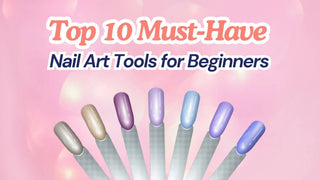Top 10 Must-Have Nail Art Tools for Beginners
Nail art is a fun, creative way to express yourself, and it has become more accessible than ever thanks to a wide range of tools designed to help you achieve professional results at home. Whether you’re a beginner or looking to upgrade your at-home manicure kit, having the right tools is key to creating stunning nail art. From simple dots to intricate designs, these essential tools will set you up for success. Let’s explore the top 10 must-have nail art tools every beginner needs, along with bonus tips to enhance your nail art journey.
1. Nail File and Buffer
Nail prep is the foundation of a great manicure. A high-quality nail file and buffer are essential for shaping your nails and creating a smooth canvas for your designs.
-
Nail File: Use a fine-grit file to shape your nails. Whether you prefer square, oval, or almond shapes, a good file ensures a precise and neat finish.
-
Buffer: Buffing smooths out ridges and creates an even surface for polish, improving the longevity of your designs.
Why It Matters: Properly shaped and prepped nails provide a durable base for any nail art, reducing the likelihood of chipping or peeling.
Pro Tip: Avoid metal files or overly coarse buffers, as they can damage your nails. Instead, opt for multi-grit files that offer versatility.
2. Base Coat and Top Coat
Base coats and top coats are often overlooked, but they’re essential for a polished and long-lasting manicure.
-
Base Coat: Protects your nails from staining, smooths imperfections, and provides a sticky surface for the polish to adhere to.
-
Top Coat: Seals in your design, adds a glossy or matte finish, and helps prevent chipping.
Why It Matters: Using a base and top coat not only improves the appearance of your manicure but also extends its wear time, making your hard work last longer.
Pro Tip: Look for quick-drying or gel-like formulas for added convenience.
3. Dotting Tools
Dotting tools are a beginner’s best friend, offering a simple yet effective way to create intricate designs. They come in various sizes for versatility.
-
How to Use: Dip the dotting tool into polish and press gently onto your nail to create dots of different sizes.
-
Creative Ideas: Use dotting tools to create polka dots, flower petals, or abstract patterns.
Why It Matters: Dotting tools make it easy to experiment with patterns and add detail to your designs without requiring advanced skills.
Pro Tip: If you don’t have a dotting tool, you can use household items like bobby pins, toothpicks, or the end of a ballpoint pen.
4. Fine Nail Art Brushes
For intricate designs and freehand art, fine brushes are a must. These brushes allow for precise strokes and detailed patterns.
-
Striping Brushes: Create thin, straight lines or geometric patterns.
-
Detail Brushes: Perfect for drawing intricate shapes like flowers or swirls.
-
Flat Brushes: Great for blending colours or creating gradient effects.
Why It Matters: Brushes provide control and flexibility, allowing you to bring your most detailed designs to life.
Pro Tip: Clean your brushes immediately after use with acetone or brush cleaner to prevent polish buildup.
5. Striping Tape
Striping tape is a simple yet powerful tool for creating clean lines and geometric patterns.
-
How to Use: Place the tape on your nail in your desired pattern, paint over it, and remove the tape carefully while the polish is still wet.
-
Creative Ideas: Use multiple colours or layer the tape for unique designs.
Why It Matters: Striping tape helps you achieve sharp, precise lines without requiring a steady hand.
Pro Tip: Ensure your base colour is completely dry before applying striping tape to avoid smudging.
6. Nail Stickers and Decals
For intricate designs without the hassle of freehand painting, nail stickers and decals are a game-changer.
-
How to Use: Peel and place the sticker onto your nail, smooth it out, and seal it with a top coat.
-
Creative Ideas: Choose from florals, geometric patterns, or themed designs like holidays or special occasions.
Why It Matters: Stickers and decals allow beginners to achieve professional-looking designs quickly and easily.
Pro Tip: Press the sticker firmly to ensure it adheres properly and avoid air bubbles.
7. Sponges for Gradient Effects
Gradient nails, also known as ombre nails, are a popular trend that’s easy to recreate with a simple makeup sponge.
-
How to Use: Apply two or more polishes onto the sponge and press it onto your nail to blend the colours seamlessly.
-
Creative Ideas: Experiment with bold summer shades or subtle pastel transitions for a unique look.
Why It Matters: Sponges provide a smooth, blended finish that looks professional with minimal effort.
Pro Tip: Use a peel-off barrier around your nails to make cleanup easier after sponging.
8. Rhinestone Applicator Tool
Adding rhinestones or other embellishments takes your nail art to the next level, and an applicator tool makes the process effortless.
-
How to Use: Dab nail glue where you want the rhinestone, pick it up with the applicator tool, and place it on the nail.
-
Creative Ideas: Create accent nails with clusters of rhinestones or use a single stone for a minimalist look.
Why It Matters: Embellishments add dimension and sparkle to your designs, making them stand out.
Pro Tip: Seal rhinestones with a gel top coat to keep them in place longer.
9. Stamping Kit
A stamping kit is a beginner-friendly tool that allows you to transfer intricate patterns onto your nails.
-
What’s Included: A stamping plate, scraper, and stamper.
-
How to Use: Apply polish to the plate, scrape off the excess, and press the stamper onto the plate to pick up the design. Transfer it to your nail.
Why It Matters: Stamping kits make it easy to achieve complex designs without the need for freehand skills.
Pro Tip: Use highly pigmented polishes for crisp, clear patterns.
10. Cleanup Brushes
Even the most careful nail artist can make mistakes, which is why cleanup brushes are essential. These small, angled brushes help tidy up the edges of your nails for a flawless finish.
-
How to Use: Dip the brush in acetone or polish remover and clean any excess polish around your cuticles.
-
Creative Hack: Use cleanup brushes to refine detailed designs.
Why It Matters: Clean edges make your manicure look polished and professional.
Pro Tip: Replace cleanup brushes regularly, as acetone can wear down the bristles over time.
Bonus Tools for Advanced Beginners
Once you’ve mastered the basics, consider adding these tools to your kit:
-
UV/LED Lamp: Essential for curing gel polish and ensuring long-lasting results.
-
Nail Art Palette: A small, reusable surface for mixing and blending colours.
Tips for Choosing Nail Art Tools
-
Invest in Quality: Durable tools last longer and provide better results.
-
Try Beginner Kits: Starter kits often include a variety of tools at an affordable price.
-
Focus on Versatility: Choose tools like dotting tools and brushes that can be used for multiple designs.
Conclusion
Creating beautiful nail art at home starts with having the right tools. These 10 must-have nail art tools will help you experiment with a variety of designs and build your skills. From dotting tools to cleanup brushes, each tool plays a role in helping you achieve professional-quality results.
As you gain confidence, you can expand your collection with advanced tools like UV lamps and stamping kits to explore even more creative possibilities. Nail art is all about having fun and expressing yourself, so don’t be afraid to try new designs and techniques.
Start building your nail art kit today and let your creativity shine!







